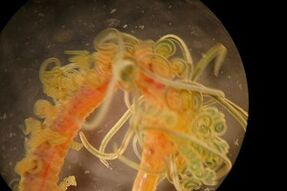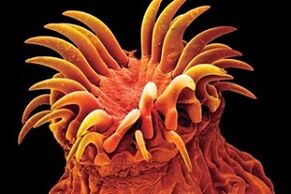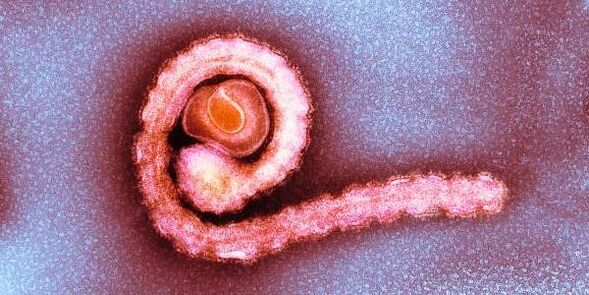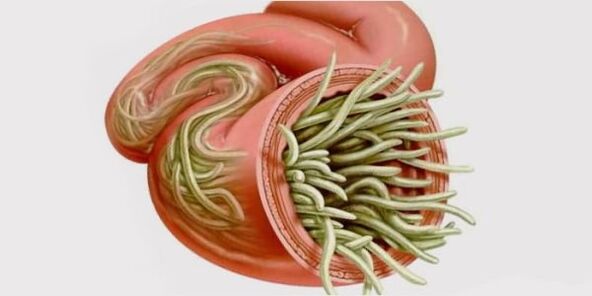
The history of helminthology goes back thousands of years.
The first documentation describing human internal parasites dates back to the 6th century BC, classifying them as roundworms according to modern classification.
The word "worm" that is ubiquitous today was coined by Hippocrates.
Since then, information about the parasite has continued to accumulate.
There are now over 100,000 species.
All these species of worms are classified as lower worms of the scolecida type (lat. Scolecida).
They are divided into four categories:
- Flatworms are a group of tapeworms and flukes;
- Roundworms, including a large group of nematodes;
- spiny-headed worms;
- Annelids.
There are the first two types of parasites that parasitize the human body (more than 250 species in total).Worms spend the main stages of their life cycle inside a person or animal, called the host.
All parasites are divided into two main categories:
- soil worm,Their development begins in the external environment and ends in the tissues of the “host”;
- biological worms,Their life activities occur only in living organisms, and during development, such worms can change multiple "hosts."
There is also a group of so-called infectious worms.These parasites in humans can be spread through close contact with an infected person; this type includes pinworms and dwarf tapeworms.
The most common nematode infections are:

- Ascariasis, caused by roundworms in humans;
- Toxocariasis, which occurs when roundworms enter an animal’s intestines;
- Trichocephaly, which occurs due to whipworm infection;
- Pinworm disease caused by pinworms;
- Hookworms, whose appearance is caused by hookworms and hookworm parasitism;
- Strongyloidiasis, which is caused by intestinal acne;
- Trichostrongyloidiasis, caused by the parasite of the same name;
- Trichinellosis caused by one of four species of Trichinella spiralis;
- Filariasis is caused by filarial worms, also known as filarial bodies.
Among taeniasis, the following diseases can be distinguished:
- diphyllobothriasis, causative agent - Taenia elongata;
- teniarinhoz caused by the bovine tapeworm;
- Taeniasis or cysticercosis caused by the pork tapeworm;
- Hymenosquamia, causative agent - dwarf tapeworm;
- Canine trichomoniasis caused by canine tapeworm parasitism;
- Hydatid disease, the cause of which is Echinococcus or Echinococcus;
- Alveolar coccosis, causative agent - alveolar cocci.
Among flukes, the following helminthiasis are frequently diagnosed:

- Fascioliasis, causative agent - Fasciolopsis;
- Opisthorchiasis, the cause of which is parasitism of cat flukes;
- Clonorchiasis caused by the fluke Sinensis;
- metaascariasis, causative agent - metaascariasis;
- Schistosomiasis (urogenital schistosomiasis, intestinal schistosomiasis, schistosomiasis japonicum) is caused by the parasite of the same name.
Another group includes the so-called protozoal diseases caused by the presence of single-celled protozoa: amoeba, Plasmodium, Trypanosoma, lamblia, Toxoplasma gondii, Trichomonas.
The average person has no idea how many parasites they deal with on a daily basis.These microorganisms are found everywhere: in soil, sandboxes, railings, common household items, toys, swimming pools, bathrooms and saunas, pond towels, pets’ fur, paws, and saliva.However, the transformation of larvae and eggs into sexually mature individuals does not always occur.In the vast majority of cases, in healthy people, the parasites die and are excreted from the intestines.
However, in the tissues of children, people with immunodeficiencies, and diseases of the digestive tract and endocrine system, the worm larvae further transform into adult males and females.
Their life activities are accompanied by:
- Metabolic disorders;
- Vitamin deficiency;
- Lack of minerals and protein;
- The formation of allergic reactions, which is fraught with the development of autoimmune processes;
- Negative effects of worms' toxic waste.
Furthermore, nearly all parasites mechanically damage various tissues at various stages of their life cycle.The larvae of many helminths (strongyloides, schistosomiasis, etc.) destroy the integrity of the skin and mucous membranes when they enter the body.Dwarf tapeworms cause changes in the structure of the epithelium of the small intestine down to the deepest layers.In the case of hydatid and asymptococcosis, as the larvae grow, mechanical compression of the surrounding tissue (usually the liver) occurs, resulting in jaundice.

The gastrointestinal tract is actively flushed with blood.The worms enter through their walls into major blood vessels and from there into almost any organ.The positioning of the main focus of parasite development determines the main symptoms of the disease.Invasion of helminths affects in one way or another the function of all organs and systems: immune, neurological, circulatory, digestive.
The severity and clinical symptoms of the lesions, as well as treatment, depend on the type of parasite.In most cases, relatively "harmless" pinworms and roundworms cause damage to the digestive tract.Entry of protozoa (e.g., amoeba) into the body can cause meningoencephalitis, pericardial lesions, and death.The parasites colonize the skin, visual organs, brain and muscle tissue.
To get rid of some worms, you can use folk remedies (pumpkin seeds, cleansing enemas with garlic and soda, taking infusions of celandine, ginger root, tansy and other medicinal plants).But in cases of severe and massive infections, herbal medicines, homeopathic drops and herbal supplements cannot be used.Eliminating worms requires long-term medical treatment and helps restore basic functions of the digestive tract.
The occurrence of helminthiasis can only be prevented by taking certain precautions.
However, in order to prevent infection, it is necessary to understand the main ways in which parasites appear in the human body:

- It is passed through the mouth through hands, unwashed food, wool, feathers of domestic animals and birds, on which parasite eggs and larvae are present, as well as soil particles.You can then become infected with ascariasis, pinworms, and giardiasis.
- Heterotrophy occurs when consumed as a food source of meat, milk, fish, and seafood that have not been thermally processed.This route of transmission is typical of trichinellosis and taeniasis.
- For example, schistosomiasis enters the body through contact through skin pores (they live in hot climates).
- Transmitted through the bloodstream through insect bites (such as filariasis).
- Toxoplasmosis is transmitted from mother to fetus through the placenta.
Taking into account the realities of modern domestic medicine, they try to postpone a visit to the doctor until the last minute, especially since drugs to eliminate helminthiasis can be purchased in every pharmacy without a prescription.But not everything is as simple as it seems at first glance.Methods to combat parasites are not identical in terms of therapeutic activity; in addition, different types of worms "require" individual selection of doses and duration of treatment.
Therefore, if you suspect that you have parasites in your body, you need to contact a specialist.The algorithm of his actions is as follows:
- Examine the patient and collect medical records (for example, recent return from a foreign country requires specialized studies to identify pests);
- Make appointments for general blood tests, stool tests, combined procedures;
- Blood tests for the presence of specific antibodies, an analysis that will accurately identify the causative agent of the disease;
- Assess the condition of internal organs, presence of abscesses, ulcers, and areas of necrosis caused by parasites;
- Identify possible concomitant medical conditions that may be contraindications to the prescription of certain medications.
This is important!
Self-treatment of worm infections is prohibited during pregnancy and breastfeeding.
Signs of internal parasites depend on location
Tissue damage caused by worms is accompanied by profuse needle-like bleeding.This can lead to anemia, weakness, fatigue, and decreased performance.As metabolic processes and the absorption of vitamins and minerals are disrupted, the condition of the skin, nails and hair worsens.A person loses weight rapidly and often suffers from viral and infectious diseases.

Moreover, the life activities of most pathogenic microorganisms are accompanied by the release of toxins.The immune system responds accordingly to their presence, so if there are parasites in the body, symptoms of an allergic reaction will certainly occur.General clinical symptoms of intoxication may also occur, manifesting as malaise, irritability, insomnia, nervous disturbance, and deterioration of health status.
The occurrence of parasitic invasion in human cardiac tissue occurs in the context of severe disturbances in myocardial function.
Patient complaints:
- shortness of breath;
- heart rate changes;
- feeling of lack of air;
- Discomfort and heaviness in the chest.
Adding an inflammatory process can cause pericarditis or myocarditis.These illnesses are accompanied by an increase in body temperature and severe pain in the heart area.
Epidermal helminthiasis is relatively rare.Usually, they occur against the background of damage to the intestines and other internal organs.
When some worms invade the skin, signs of internal parasites may look like the following:

- Ulcers at the site of contact with feces;
- An itchy rash develops;
- Swelling and redness, sometimes during worm migration;
- Formation of swelling that resembles a swelling in appearance;
- The appearance of purulent acne.
The symptoms of parasites entering the eye depend on several factors.If the parasite "lives" under the skin of the eyelid, its movement can be felt and even seen.However, when the worms penetrate deep into the optic nervous system, there is a risk of strabismus, severe visual impairment, and limited visibility.Without appropriate treatment, the development of ocular helminthiasis may lead to irreversible blindness.
The gastrointestinal tract is home to the vast majority of worms.This is why if the parasite appears in the human body, symptoms appear mainly in the digestive system.
Patients usually complain of:
- Abdominal pain and discomfort of varying intensity;
- Diarrhea, which can be replaced by constipation, is especially common in the early stages of infection;
- Stool containing mucus and blood;
- Painful cramping that coincides with the urge to defecate;
- Decreased or absent appetite;
- Gas, bloating.
Due to damage to the digestive glands, a person will constantly feel a heaviness in the stomach.In some cases, roundworm balls can cause intestinal obstruction.
Invasion of the hematopoietic system by worms can lead to systemic disorders.Furthermore, this invasion sometimes does not manifest itself in the form of external symptoms.However, due to the destruction of red blood cells and other formed components, symptoms such as headache, dizziness, drowsiness, persistent weakness, and intolerance to physical activity often occur despite observing daily routines.
In addition, signs of parasites in the body's circulation are accompanied by swollen lymph nodes and exacerbation of chronic diseases.The size of the liver and spleen changes upward, and body temperature often increases.
Doctors stress that the discovery of foreign "organisms" in the body should not be a reason to panic.Modern medicines can quickly and without any side effects purify all worm organs and completely restore their functions.
Human Parasites: Treatment and Prevention Methods
Recently, a number of private clinics announced the creation of a new, safe way to combat worms - bioresonance therapy.The principle of this treatment is based on the laws of physics.According to the theory of the method's developers, each cell in our body does not sit still in one place, but is in a constant vibrating mode, emitting electromagnetic waves.Each internal organ is different in length.
Human parasites are no different, but they move in a different resonance than our body's tissues.During bioresonance therapy, metal electrodes are applied to certain biologically active points.They emit waves of a given length that do not affect the function of the person's own cells but damage the parasite's body.

Advantages of bioresonance therapy include safety and painlessness.However, the clinical effect of this treatment method has not been proven, and the treatment equipment does not have corresponding certificates.However, exposure to electromagnetic waves does not cause any harm and does not cause complications.
There really aren't that many drugs that can be used to get rid of worms and protozoa.Doctors choose the dose, treatment regimen and duration of the drug based on the patient's age, severity of invasion and presence of accompanying pathology.
For relatively minor helminth infections, traditional medicinal formulations are recommended.These products can be easily prepared at home and their ingredients are available in any pharmacy.
To expel worms from the intestines, therapists recommend:
- Eat as much onions, garlic, ginger and pomegranates as possible.
- Buy regular cloves for cooking.Grind it in a coffee grinder and take it according to the following regimen: on the first day 0.5 g, on the second day - 1 g, on the third to ninth days - 1.5 g in the morning on an empty stomach.
- Add a tablespoon of crushed and dried nettle root to a cup of boiling water and cook in a water bath for 15 minutes.Allow to cool completely and serve 3 tablespoons.Take it three times a day before meals.
- Mix aloe vera and onion juice in equal proportions, add honey, and take one tablespoon three times a day for several weeks.
- Mix 10 Tbsp.l. flaxseed and 1 tbsp.Grind the cloves finely and take 2.5 grams of powder per 1 kilogram of body weight.
- Mix grated coconut milk and coconut milk.Use 1 tsp of this mixture.Take 3 times a day on an empty stomach.
Almost the only way to prevent the appearance of human parasites in the intestines and other tissues is to strictly observe the rules of hygiene that have been known since childhood.This is washing hands before eating, after using the toilet and after returning from a walk.Careful heat treatment of drinking water, milk, meat, fish and removal of contaminants from fresh vegetables and fruits is also required.
But human parasites appear every step of the way, making it nearly impossible to avoid encountering them.To prevent severe invasive complications, immune defenses need to be strengthened and the status of the digestive tract needs to be monitored.When the first symptoms of helminthiasis appear, you must consult a doctor, undergo prescribed examinations and complete the entire course of treatment, with mandatory monitoring of its effectiveness.

















































